
Swallow-tailed gull, Izabela Island, Galapagos.
Gulls of Galapagos Islands
The two resident gull species of the Galapagos are beautiful examples of island
evolution. It's a pity that their biology was largely unknown at the time of Darwin's
visit to the archipelago - he would certainly enjoy studying this living illustration
to his theory. I was more lucky than him, because during my trip to the Galapagos
in 1995, I could pay these birds all the attention they deserved. Here are some
photos from that trip.
|
| Swallow-tailed gull (Larus furcatus, commonly called Creagrus furcatus)
is an unusual bird. It breeds on the Galapagos and few other small islands off
Pacific coast of tropical South America. It has evolved from a smaller species, Sabine's
gull (L. sabini), which nests in wet tundra along Arctic coasts, particularly
in Yakutia, but winters around the Galapagos. |
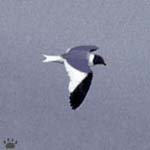
Sabine's gull, Pevek, Chukotka. |
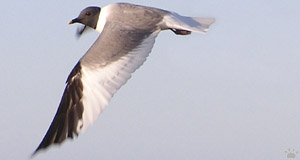
Sabine's gull, Russkaya Koshka Spit, Chukotka. |
Both species can also be seen in
winter throughout tropical Eastern Pacific (Sabine's gull - also in Southeastern
Atlantic Ocean). As swallow-tailed gull can nest at any time of the year, "winter"
is not well defined for it, but most birds disperse during October-February. |
| Some northern gulls, including Sabine's, become partly
nocturnal when they come to the tropics in winter. This allows them to avoid overheating,
as well as being robbed by frigatebirds (Fregata). Their food - small fish,
squid and large plankton - is also more available at night, when it comes close
to surface. When the ancestors of swallow-tailed gulls started nesting on the
Galapagos instead of returning to the North, they probably suffered heavily from
frigatebirds, so they became the most nocturnal of all gulls. |
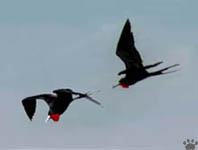
Magnificent frigatebirds (Fregata magnifica),
San Cristobal I, Galapagos. |
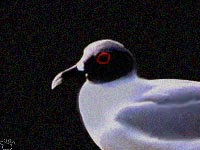
Close-up of a swallow-tailed gull,
Baltra Island, Galapagos. |
They developed some interesting adaptations to nocturnal lifestyle:
in addition to large, very light-sensitive eyes, they have red eyering, which
supposedly improves their ability to see bioluminescence. As soon as frigatebirds
appear at dawn, gulls are usually forced to stop hunting, because their prey would
be forcefully taken from them anyway. Breeding birds return to their nests before
dawn, to avoid been robbed near the nesting site, and stay there all day. Probably
because of their nocturnal habits, they are only slightly darker than Sabine's
gulls, while most other tropical gulls have dark "sunscreen" plumage. |
| They are not, however, blinded by bright artificial
light sources, and often follow ships at night, when ship's lights attract squid,
their favorite prey. So, you can use a flash to take their pictures at night,
without risk of damaging their eyesight. Unlike the eyes of many other nocturnal
birds, their eyes do not reflect light. The habit of following ships is a possible
reason for some recent records of these gulls outside their normal range: off
Central Chile, Panama, and even near Monterey in Northern California. |
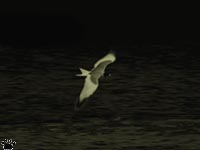
Swallow-tailed gull at sea,
off Isla de La Plata, Ecuador. |
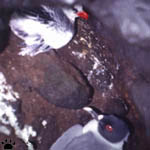
Swallow-tailed gull and tropicbird
in a nesting cave, Islas Plazas. |
Swallow-tailed gulls nest on small offshore islets, on lava cliffs
or under bushes; the majority of nests is probably hidden in deep niches and small
caves, where they are often joined by red-billed tropicbirds (Phaethon aethereus).
Males have an unusual habit of swallowing small pebbles and then regurgitating
them at nest site during nest construction. They only lay one egg; it is believed
that the white bill tip helps the chick find the source of food when its parents
return from the sea at night. Males prefer to return to the same nesting sites
every year, but females and young birds usually change nest sites after each breeding
season. |
| Like most other birds of the Galapagos, these gulls
are very tame. They can easily be seen at nesting colonies at Islas Plazas and
in other parts of the archipelago. (To look inside nesting caves, you'll need
somebody to hold your legs, while you hang over the cliff edge.) It is believed
that there are about 7000 pairs of swallow-tailed gulls on the Galapagos, and
less than 100 on other islands; the total World's population is estimated at 30
000 birds. |
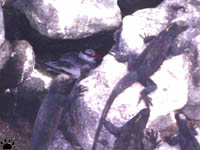
Nesting cave of gulls and tropicbirds,
surrounded by marine iguanas, Islas Plazas. |
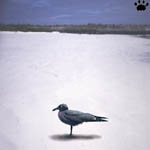
Lava gull, Santa Cruz Island. |
The other Galapagos species, lava gull (L. fuliginosus),
is much more rare: there are less than 400 breeding pairs. This is a typical "dark"
tropical gull. Unlike all other gulls, lava gull is highly sedentary,
and have never been recorded outside the Galapagos. It is a scavenger, and commonly
feeds along the coast, looking for eggs, small lizards, small fish and scraps;
it can also steal fish from pelicans, and crabs from herons. |
| Lava gull often hangs around
sea lions or people, and, despite its rarity, it is easy to see in any port of
the Galapagos. It nests in small lava caves, rocky outcrops, or on remote beaches.
Nesting birds are extremely vary of people, unlike most other Galapagos inhabitants. |

Lava gull and sea lions (Zalophus californianus),
Santa Cruz Island, Galapagos. |
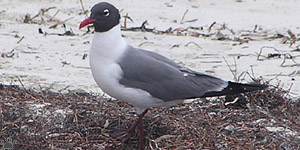
Laughing gull, Miami, Florida. |
Lava gull has probably evolved from laughing gull (L. atricilla), a
common bird of the tropical coasts of the Americas, which accidentally visits the Galapagos. |

Close-up of lava gull, Santa Cruz Island, Galapagos.
Home
|
|